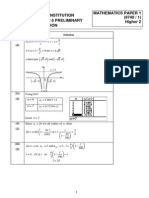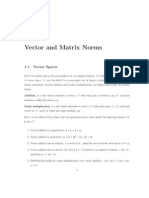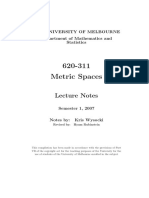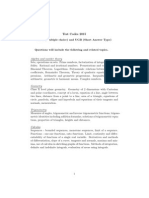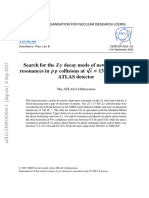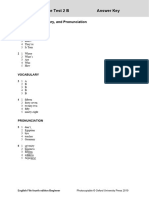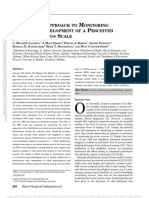Wing Hong Tony Wong: ND TH
Uploaded by
PeterWing Hong Tony Wong: ND TH
Uploaded by
PeterMATH 2010E ADVANCED CALCULUS I
LECTURE 1
WING HONG TONY WONG
Course information
Instructor
Email
Course website
Office
Office Hour
Wing Hong Tony Wong
whwong@math.cuhk.edu.hk
http://www.math.cuhk.edu.hk/course/math2010e/
Lady Shaw Building (LSB) 233
TH 1:30pm 2:15pm
Assessment scheme
HW
Mid-term
Final
15%
35%
50%
Tuesday, 2nd June, 2015 (Tentative)
Thursday, 25th June, 2015
Outline of the course
In the past, we have dealt with calculus about functions on a single variable, i.e.
f : R ! R. Examples of such functions include
p
Polynomials: f (x) = 4x3 + 83 x
5;
Trigonometric functions: f (x) = sin(x), f (x) = cos(x3 );
Exponentials and Logarithms: f (x) = ex , f (x) = 34x+2 , f (x) = log6 (x).
Calculus has two branches: dierentiation and integration.
Dierentiation
df 0
, f (x).
dx
Tangent lines, slopes.
Product rule, Quotient rule, Chain rule.
Taylors theorem.
Implicit dierentiation.
Finding maximum/minimum of f (x).
Integration
Z
Z b
f (x)dx,
f (x)dx.
a
Areas under curve.
Substitution, Integration by part.
Finding volume of revolution.
Date: Tuesday, 12th May, 2015.
1
The relation between dierentiation and integration is given by the following.
Fundamental Theorem(s) of Calculus
Z b
(1)
f 0 (x)dx = f (b) f (a).
a
Z x
d
(2)
f (t)dt = f (x).
dx a
In Advanced Calculus, we deal with calculus about functions on multivariables, i.e.
F : Rn ! Rm , and
F (x1 , . . . , xn ) = f1 (x1 , . . . , xn ), . . . , fm (x1 , . . . , xn ) .
MATH 2010 deals with
Dierentiation;
Related problems such as maximization and minimization of F (x1 , . . . , xn ) subject
to constraints.
MATH 2020 deals with
Integration;
Related problems such as fundamental theorem of calculus.
Acknowledgement: All the lecture notes in this course will follow very closely to those
by Dr. Martin Li.
12.1 Three-dimensional coordinate systems
A real line is a one-dimensional object, denoted by R. Every point on the line is a real
number x.
A Cartesian coordinate plane, or a rectangular coordinate plane, is a two-dimensional
coordinate system. Every point on the plane is denoted by coordinates
(x, y),
where x and y are real numbers. The Cartesian coordinate plane is often denoted by
R R, or R2 . In set notation,
R2 = {(x, y) : x, y 2 R}.
Question 1.
(a) What does the equation x2 + y 2 4y 2 = 0 correspond to in R2 ?
(b) What does the inequality 3x 2y > 8 correspond to in R2 ?
(c) What does the inequality y x2 correspond to in R2 ?
(d) Why is there a correspondence between an algebraic equation or inequality and a
geometric figure in R2 ?
Question 2.
(a) What is the equation of the x-axis in R2 ?
(b) What does the equation x = 3 correspond to in R2 ?
2
A three-dimensional Cartesian coordinate space is denoted by R3 . Every point on the
plane is denoted by coordinates
(x, y, z),
where x, y, and z are real numbers. In set notation,
R3 = {(x, y, z) : x, y, z 2 R}.
Question 3.
(a) How are the three axes in R3 arranged?
(b) What is the equation of the x-axis in R3 ? (Beware of the trap!)
(c) What does the equation x = 3 correspond to in R3 ?
In R3 , the equations x = 0, y = 0, and z = 0 correspond to the yz-plane, xz-plane,
and xy-plane respectively. The x-axis is the intersection of the xy-plane and xz-plane,
so it is described by a system of linear equations
n
y=0
.
z=0
Roughly speaking, each equation is a restriction to the dimension of freedom, hence in
R , one equation corresponds to a two-dimensional surface, and a system of two equations
usually corresponds to a one-dimensional curve.
3
Example 4. Interpret the following equations and inequalities geometrically.
(a) z 2
half-space on or above the plane z = 2.
(b) z = 0, x 0, y 0 second quadrant of the xy-plane.
(c) x 0, y 0, z 0 first octant.
(d)
1y1
slab between the planes y = 1 and y = 1 (planes included).
(e) y = 2, z = 2
straight line parallel to x-axis through the point (0, 2, 2).
Theorem 5. Let (x1 , y1 , z1 ) and (x2 , y2 , z2 ) be two points in R3 . Then the distance
between them is
p
(x1 x2 )2 + (y1 y2 )2 + (z1 z2 )2 .
The equation of a sphere with radius r and center (x0 , y0 , z0 ) is
(x
x0 )2 + (y
y0 )2 + (z
z0 )2 = r 2 .
Example 6. Interpret the following equations and inequalities geometrically.
interior of the sphere with radius 4 and
(a) (x 1)2 + (y + 2)2 + (z 3)2 < 16
center (1, 2, 3).
solid ball with radius 4 and center
(b) (x 1)2 + (y + 2)2 + (z 3)2 16
(1, 2, 3).
exterior of the sphere with radius 4 and
(c) (x 1)2 + (y + 2)2 + (z 3)2 > 16
center (1, 2, 3).
lower hemisphere with radius 4 and cen(d) (x 1)2 + (y + 2)2 + (z 3)2 = 16, z 0
ter (1, 2, 3) (equator included).
Exercise 7. Interpret the following equations and inequalities geometrically.
(a) (12.1.14) x2 + y 2 + z 2 = 4, y = x.
(b) (12.1.20b) x2 + y 2 1, z = 3.
(c) (12.1.56) x2 + y 2 + z 2 6y + 8z = 0.
Exercise 8. (12.1.26b) Describe the given set with a single equation or with a pair of
equations.
The plane through the point (3, 1, 2) perpendicular to the y-axis.
12.2 Vectors
More generally, we can talk about the n-dimensional Euclidean space
Rn = {(x1 , x2 , . . . , xn ) : x1 , x2 , . . . , xn 2 R}.
A point x = (x1 , x2 , . . . , xn ) in Rn is also referred as a position vector, with the tail of
the vector at the origin 0 = (0, 0, . . . , 0), and the head of the vector at the point x. In
hand-written form, we also write x as !
x.
A vector from the point x to the point y is given by y x = (y1 x1 , . . . , yn xn ). The
sum of two vectors x+y = (x1 +y1 , . . . , xn +yn ) can be found by the parallelogram law.
The length, or the norm of a vector x = (x1 , . . . , xn ) is given by the Euclidean formula
q
kxk = x21 + + x2n ,
and the distance between points x and y is given by the norm of the vector y
p
ky xk = (x1 y1 )2 + + (xn yn )2 .
x, i.e.
In this course, a scalar is simply a real number. The relationship between x and the
scalar multiplication x = ( x1 , . . . , xn ) is given by the following table.
>0
<0
| |>1
| |<1
x
x
x
x
and x are in the same direction
and x are in opposite directions
is a stretching of x
is a shrinking of x
Here is a list of properties of vector addition and scalar multiplication.
(1) (commutative) x + y = y + x.
(2) (associative) (x + y) + z = x + (y + z).
(3) (existence of additive identity) x + 0 = x.
(4) (existence of additive inverse) x + ( x) = 0.
(5) (distributive) (x + y) = x + y.
(6) (distributive) ( 1 + 2 )x = 1 x + 2 x.
(7) (associative with scalar multiplication) 1 ( 2 x) = ( 1 2 )x.
(8) (fixed by scalar multiplication of 1) 1x = x.
Hence, Rn with addition and scalar multiplication defined forms a vector space (introduced in MATH 1030 Linear Algebra).
4
A set of vectors {v1 , . . . , vn } forms a basis of Rn if every u in Rn can be written
uniquely as
u = k1 v 1 + kn v n .
n
The standard basis of R is e1 = (1, 0, . . . , 0), e2 = (0, 1, 0, . . . , 0), . . . , en = (0, . . . , 0, 1) .
Question 9. We know that e1 , . . . , en are mutually orthogonal in Rn . How many different ways are there to arrange them? (We consider two ways the same if one can be
obtained from the other by rotation.)
It turns out that the answer to Question 9 is a generalization to that of Question 3(a).
There is a general technique to decide between left-handed orientation and righthanded orientation, and the method is called the determinant of a matrix.
a b
For a 2 2 matrix
, the determinant is given by
c d
a b
= ad
c d
bc;
1
a b c
for a 3 3 matrix @d e f A, the determinant is given by the arrow method
g h i
a b c
d e f = aei + bf g + cdh
g h i
(ceg + bdi + af h).
Warning: For 4 4 or larger matrices, the determinant CANNOT be found by using
the arrow method.
The orientation is right-handed if the determinant is positive, and the orientation is
left-handed if the determinant is negative.
b.
A vector v is a unit vector if the norm is 1. In this situation, we also write v as v
For every vector v,
v
b=
v
.
kvk
b records the direction of v, while the norm kvk records the length of
The unit vector v
v. In other words,
v = kvkb
v.
Finally, the midpoint m between the two points x and y is given by
1
x1 + y1
xn + yn
m = (x + y) =
,...,
.
2
2
2
12.3 Dot product
In Rn , the dot product, or the inner product between x and y is defined to by
x y = x1 y1 + x2 y2 + + xn yn .
5
Note that the norm kxk =
x x.
Here is a list of properties of dot product.
(1) (commutative) x y = y x.
(2) (distributive) (x + y) z = x z + y z.
(3) (associative with scalar multiplication) ( x) y = (x y).
(4) (positive definite) x x 0, and = holds if and only if x = 0.
Warning: There is no such thing as (x y) z, why?
The geometric interpretation of dot product is given by the following theorem.
Theorem 10.
x y = kxkkyk cos ,
where is the angle between the vectors x and y.
Proof. Consider the triangle bounded by vectors x, y and y
Notice that
xk2 = kxk2 + kyk2
ky
L.H.S. = (y
x) (y
= y (y
x)
=yy
xy
= (y
= kyk2
x) y
x. By cosine law,
2kxkkyk cos .
x)
x (y
(y
x)
x) x
yx
2x y + kxk2 .
(by distributivity)
(by commutativity)
xx
(by distributivity)
(by commutiativity)
By comparing with R.H.S., we have our desired conclusion.
Corollary 11. The nonzero vectors x and y are orthogonal to each other if and only if
x y = 0.
Let projy x be the projection vector of x onto the direction of y. By the definition of
projection,
kprojy xk = kxk cos ,
b. Therefore,
where is the angle between x and y. Also, projy x takes the direction y
y
projy x = kxk cos
kyk
y
= kxkkyk cos
kyk2
xy
=
y,
yy
and
xy
b.
kprojy xk =
=xy
kyk
Example 12. Find projy x and kprojx yk if x = (5, 2, 6) and y = (3, 1, 2).
Here are some applications of dot product.
(1) Compute the angle between two vectors x and y:
xy
cos =
.
kxkkyk
(2) Detect orthogonality between x and y (see Corollary 11).
(3) Define a plane containing the origin in R3 using the normal vector, i.e.
{v 2 R3 : v x = 0}.
b.
(4) Find a component of a vector: x v
(5) Cauchy-Schwarz inequality:
(x1 y1 + + xn yn )2 (x21 + + x2n )(y12 + + yn2 ).
Proof. L.H.S. = x y = (kxkkyk cos )2 = kxk2 kyk2 cos2 kxk2 kyk2 = R.H.S.
Example 13.
12.1
26b, 38, 59.
12.3
22.
You might also like
- 2014 H2 Maths Prelim Papers - RJC P1 Solution PDFNo ratings yet2014 H2 Maths Prelim Papers - RJC P1 Solution PDF12 pages
- Math100, 3-Dimensional Space Vectors: 1.1 Rectangular CoordinatesNo ratings yetMath100, 3-Dimensional Space Vectors: 1.1 Rectangular Coordinates8 pages
- Yogesh Meena (BCA-M15 4th SEM) CONM CCENo ratings yetYogesh Meena (BCA-M15 4th SEM) CONM CCE10 pages
- College Algebra_Math Assignment_U4- 2024No ratings yetCollege Algebra_Math Assignment_U4- 202415 pages
- Linear Equations in two variables_Test Papers(Class-9No ratings yetLinear Equations in two variables_Test Papers(Class-97 pages
- IX Math-Linear Equations in two variablesNo ratings yetIX Math-Linear Equations in two variables5 pages
- Binomial Logarithmic Geometric Exponential.: MathematicsNo ratings yetBinomial Logarithmic Geometric Exponential.: Mathematics18 pages
- General Theory of Relativity For Undergraduates - Chapter 1No ratings yetGeneral Theory of Relativity For Undergraduates - Chapter 129 pages
- Lecture Notes On Fundamentals of Vector SpacesNo ratings yetLecture Notes On Fundamentals of Vector Spaces30 pages
- Topic 5 Linear Combination Linear Dependence Spanning, Orthogonal-WordNo ratings yetTopic 5 Linear Combination Linear Dependence Spanning, Orthogonal-Word12 pages
- Assignment 4 Answers Math 130 Linear AlgebraNo ratings yetAssignment 4 Answers Math 130 Linear Algebra3 pages
- Solutions To Tutorial 1 (Week 2) : Lecturers: Daniel Daners and James ParkinsonNo ratings yetSolutions To Tutorial 1 (Week 2) : Lecturers: Daniel Daners and James Parkinson11 pages
- ISI Sample Question 2015 For B.stat & B.math100% (1)ISI Sample Question 2015 For B.stat & B.math9 pages
- Alternative Real Division Algebras of Finite Dimension: Algebras de Divisi On Alternativas Reales de Dimensi On FinitaNo ratings yetAlternative Real Division Algebras of Finite Dimension: Algebras de Divisi On Alternativas Reales de Dimensi On Finita9 pages
- 10.2 Vectors in Space: Coordinate Frame. WhenNo ratings yet10.2 Vectors in Space: Coordinate Frame. When11 pages
- Student's Solutions Manual and Supplementary Materials for Econometric Analysis of Cross Section and Panel Data, second editionFrom EverandStudent's Solutions Manual and Supplementary Materials for Econometric Analysis of Cross Section and Panel Data, second editionNo ratings yet
- Clait Unit 4 Spreadsheets Exercise 8: FruitNo ratings yetClait Unit 4 Spreadsheets Exercise 8: Fruit2 pages
- Ethics of Using LLMs in Content Moderation On TwitterNo ratings yetEthics of Using LLMs in Content Moderation On Twitter7 pages
- National Case Management System FrameworkNo ratings yetNational Case Management System Framework61 pages
- Search For The Decay Mode of New High-Mass Resonances in Collisions at ATLAS DetectorNo ratings yetSearch For The Decay Mode of New High-Mass Resonances in Collisions at ATLAS Detector36 pages
- Tools and Materials List For Making The Bulletproof Glide (Jerk) Bait Fishing Lure100% (2)Tools and Materials List For Making The Bulletproof Glide (Jerk) Bait Fishing Lure4 pages
- Perencangan Esin Cetak Kue Tradisional Aceh (Karra)No ratings yetPerencangan Esin Cetak Kue Tradisional Aceh (Karra)7 pages
- Computer Fundamental - I Practical FileNo ratings yetComputer Fundamental - I Practical File32 pages
- The Book of The Seven Rings of The Planets of Messalah Mihai Vârtejaru100% (3)The Book of The Seven Rings of The Planets of Messalah Mihai Vârtejaru83 pages
- Mechanics of Balsa (Ochroma Pyramidale) Wood: MIT Open Access ArticlesNo ratings yetMechanics of Balsa (Ochroma Pyramidale) Wood: MIT Open Access Articles49 pages
- DBM-CSC Form No. 1 Position Description Form100% (1)DBM-CSC Form No. 1 Position Description Form26 pages
- Organizational Context: Industry Type Iron and Steel, in The B2B SegmentNo ratings yetOrganizational Context: Industry Type Iron and Steel, in The B2B Segment6 pages
- Most Common Questions (Ciq Type) Education Work Related (If Applicable)No ratings yetMost Common Questions (Ciq Type) Education Work Related (If Applicable)1 page
- A Practical Approach To Monitoring Recovery .7No ratings yetA Practical Approach To Monitoring Recovery .79 pages
- Math100, 3-Dimensional Space Vectors: 1.1 Rectangular CoordinatesMath100, 3-Dimensional Space Vectors: 1.1 Rectangular Coordinates
- Linear Equations in two variables_Test Papers(Class-9Linear Equations in two variables_Test Papers(Class-9
- Binomial Logarithmic Geometric Exponential.: MathematicsBinomial Logarithmic Geometric Exponential.: Mathematics
- General Theory of Relativity For Undergraduates - Chapter 1General Theory of Relativity For Undergraduates - Chapter 1
- Topic 5 Linear Combination Linear Dependence Spanning, Orthogonal-WordTopic 5 Linear Combination Linear Dependence Spanning, Orthogonal-Word
- Solutions To Tutorial 1 (Week 2) : Lecturers: Daniel Daners and James ParkinsonSolutions To Tutorial 1 (Week 2) : Lecturers: Daniel Daners and James Parkinson
- Alternative Real Division Algebras of Finite Dimension: Algebras de Divisi On Alternativas Reales de Dimensi On FinitaAlternative Real Division Algebras of Finite Dimension: Algebras de Divisi On Alternativas Reales de Dimensi On Finita
- Transformation of Axes (Geometry) Mathematics Question BankFrom EverandTransformation of Axes (Geometry) Mathematics Question Bank
- Student's Solutions Manual and Supplementary Materials for Econometric Analysis of Cross Section and Panel Data, second editionFrom EverandStudent's Solutions Manual and Supplementary Materials for Econometric Analysis of Cross Section and Panel Data, second edition
- A-level Maths Revision: Cheeky Revision ShortcutsFrom EverandA-level Maths Revision: Cheeky Revision Shortcuts
- Ethics of Using LLMs in Content Moderation On TwitterEthics of Using LLMs in Content Moderation On Twitter
- Search For The Decay Mode of New High-Mass Resonances in Collisions at ATLAS DetectorSearch For The Decay Mode of New High-Mass Resonances in Collisions at ATLAS Detector
- Tools and Materials List For Making The Bulletproof Glide (Jerk) Bait Fishing LureTools and Materials List For Making The Bulletproof Glide (Jerk) Bait Fishing Lure
- Perencangan Esin Cetak Kue Tradisional Aceh (Karra)Perencangan Esin Cetak Kue Tradisional Aceh (Karra)
- The Book of The Seven Rings of The Planets of Messalah Mihai VârtejaruThe Book of The Seven Rings of The Planets of Messalah Mihai Vârtejaru
- Mechanics of Balsa (Ochroma Pyramidale) Wood: MIT Open Access ArticlesMechanics of Balsa (Ochroma Pyramidale) Wood: MIT Open Access Articles
- Organizational Context: Industry Type Iron and Steel, in The B2B SegmentOrganizational Context: Industry Type Iron and Steel, in The B2B Segment
- Most Common Questions (Ciq Type) Education Work Related (If Applicable)Most Common Questions (Ciq Type) Education Work Related (If Applicable)

